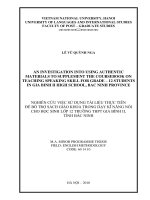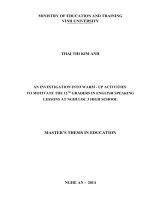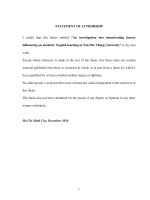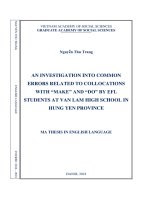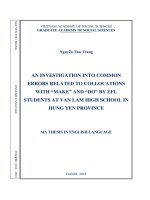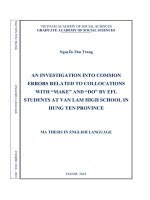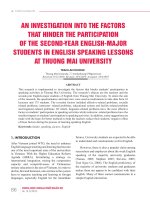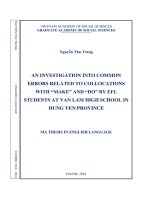An investigation into potential factors leading to efl students’ anxiety and their coping strategies when giving in class oral presentation at tuy phuoc no 3 high school
Bạn đang xem bản rút gọn của tài liệu. Xem và tải ngay bản đầy đủ của tài liệu tại đây (818.41 KB, 99 trang )
MINISTRY OF EDUCATION AND TRAINING
QUY NHON UNIVERSITY
NGUYEN TRUONG THUY TRANG
AN INVESTIGATION INTO POTENTIAL FACTORS
LEADING TO EFL STUDENTS’ ANXIETY AND THEIR
COPING STRATEGIES WHEN GIVING IN-CLASS ORAL
PRESENTATION AT TUY PHUOC NO. 3 HIGH SCHOOL
MASTER THESIS OF THEORY AND METHODOLOGY OF
ENGLISH LANGUAGE TEACHING
Binh Dinh – 2023
BỘ GIÁO DỤC VÀ ĐÀO TẠO
TRƯỜNG ĐẠI HỌC QUY NHƠN
NGUYỄN TRƯƠNG THÙY TRANG
KHẢO SÁT NHÂN TỐ GÂY LO LẮNG Ở HỌC SINH EFL
KHI THUYẾT TRÌNH TRÊN LỚP TẠI TRƯỜNG
TRUNG HỌC PHỔ THÔNG SỐ 3 TUY PHƯỚC VÀ
CHIẾN LƯỢC ĐỐI PHÓ ĐƯỢC HỌC SINH SỬ DỤNG
Ngành : Lý luận và Phương pháp dạy học bộ môn Tiếng Anh
Mã số : 8140111
Người hướng dẫn: Tiến sĩ NGUYỄN TIẾN PHÙNG
i
STATEMENT OF AUTHORSHIP
I hereby certify that the work I completed for my Master of Arts thesis, "AN
INVESTIGATION INTO POTENTIAL FACTORS LEADING TO EFL
STUDENTS’ ANXIETY AND THEIR COPING STRATEGIES WHEN GIVING
IN-CLASS ORAL PRESENTATION AT TUY PHUOC NO. 3 HIGH SCHOOL,"
was entirely original and under the supervision of Quy Nhon University lecturer Dr.
Nguyen Tien Phung. Besides, I have not turned in this thesis to any other university
or college for any other degree. Additionally, I confirm that this thesis does not
contain any previously written or published works, with the exception of those that
are specifically referenced in the thesis.
Author’s signature
Nguyễn Trương Thùy Trang
ii
ACKNOWLEDGEMENT
First and foremost, I sincerely thank my supervisor, Dr. Nguyen Tien Phung,
for being an inspiration and guidance for the majority of my graduate work. The
accomplishment of my M.A. thesis has been greatly aided by his insightful counsel,
insightful criticism, patient assistance, and tremendous encouragement.
Then, I would want to express my gratitude to Quy Nhon University's
instructors, lecturers, and professors for their patient and sincere efforts in sharing
important information and advice with me during my academic career, especially
Assoc. Prof Dr. Nguyen Thị Thu Hien. Her mentoring together with Dr. Phung's
passionate support inspired me a lot and pushed me to continue pursuing this study
issue, even if doing such unusual research has its initial challenges. This project
would not be where it is now if not for the patient consideration of these two
thoughtful people.
Moreover, it is inevitable that many other writers' thoughts in this topic will
be reflected and expanded in the thesis. Their concepts have prompted me to
consider writing this paper. I am also deeply indebted to the writers cited in the
references. I shall always be grateful to each and every one of these scholars. I shall
always be indebted to all of these scholars.
In addition, I really appreciate the all the teachers and students at Tuy Phuoc
No. 3 High School, whom I chose to be the research's target subjects, for their
enthusiastic support, collaboration, and significant assistance during the research
process.
Finally, I would want to thank my wonderful family, friends, and coworkers
for their unwavering belief in me, support during the writing of my thesis, and
overall greatness. They will always be a tremendous source of inspiration and
support. I also dedicate this work to my parents, who have always supported my
lifelong pursuit of knowledge.
iii
ABSTRACT
Foreign language learning anxiety has been extensively explored and
investigated in English as a Foreign Language situations. However, there has been
little research conducted in Vietnamese settings on this issue, particularly anxiety
about oral tasks in English classes. The current study looked at foreign language
anxiety in EFL students at Tuy Phuoc No. 3 High School. It attempted to uncover
potential factors that may contribute to EFL students' anxiety during in-class
English oral presentations, as well as the strategies that they utilized to deal with
such anxiety. To pursuit this aim, this study employed both quantitative and
qualitative methods. Classroom observations were combined with questionnaires
distributed to 40 EFL high school students, followed by semi-structured interviews
with six of these 40 students. The study's questionnaires and interviews found that
internal factors from participants and environmental factors from their physical
environments are two major sources of anxiety among students. At the same time,
the results of analyzing observation and interview data revealed that the students
utilized two types of strategies to minimize their anxiety, namely short-term coping
strategies and long-term coping strategies. Based on the study's findings, many
suggestions are recommended for English teachers as well as learners, which can be
useful in helping students avoid negative speaking habits and produce successful
presentation performances. However, anxiety in in-class oral tasks is regarded as
multifaceted and complicated, and hence still requires further investigation.
iv
TABLE OF CONTENTS
STATEMENT OF AUTHORSHIP ..........................................................................i
ACKNOWLEDGEMENT ........................................................................................ii
ABSTRACT ............................................................................................................. iii
TABLE OF CONTENTS.........................................................................................iv
LIST OF ABBREVIATIONS.................................................................................vii
LIST OF TABLES ................................................................................................ viii
CHAPTER 1. INTRODUCTION ............................................................................1
1.1 RATIONALE ...................................................................................................1
1.2 RESEARCH AIMS AND OBJECTIVES......................................................2
1.2.1 Research aim ..............................................................................................2
1.2.2 Research objectives.....................................................................................2
1.3 RESEARCH QUESTIONS.............................................................................3
1.4 SCOPE OF THE STUDY ...............................................................................3
1.5 SIGNIFICANCE OF THE STUDY ...............................................................3
1.6 ORGANIZATION OF THE STUDY ............................................................4
CHAPTER 2. LITERATURE REVIEW ................................................................5
2.1 ANXIETY .........................................................................................................5
2.1.1 Definition of anxiety...................................................................................5
2.1.2 Types of anxiety ..........................................................................................5
2.1.3 Foreign language anxiety ..........................................................................6
2.1.4 Foreign language speaking anxiety...........................................................9
2.2 THEORETICAL BACKGROUND OF ORAL PRESENTATION ...........9
2.2.1 Concepts of speaking activities ..................................................................9
2.2.2 In – class oral presentation as a speaking activity ..................................10
2.2.3 Components of speaking for assessment .................................................11
2.3 FACTORS CAUSING FOREIGN LANGUAGE ANXIETY IN
PRESENTATION ................................................................................................ 11
2.4 STRATEGIES FOR COPING WITH IN-CLASS ORAL
PRESENTATION ANXIETY ............................................................................17
2.4.1 Short-term coping strategies ....................................................................18
2.4.2 Long-term coping strategies.....................................................................18
v
2.5 PREVIOUS STUDIES...................................................................................20
2.6 SUMMARY OF CHAPTER 2 ......................................................................24
CHAPTER 3. METHODOLOGY .........................................................................25
3.1 RESEARCH DESIGN...................................................................................25
3.2 PARTICIPANTS ...........................................................................................25
3.3 RESEARCH SETTING ................................................................................26
3.4 DATA COLLECTION ..................................................................................27
3.4.1 Questionnaire ...........................................................................................27
3.4.2 Observation ...............................................................................................30
3.4.3 Interview ...................................................................................................31
3.5 DATA ANALYSIS.........................................................................................32
3.5.1 Questionnaire ...........................................................................................32
3.5.2 Observation ...............................................................................................33
3.5.3 Interview ...................................................................................................33
3.6 RESEARCH PROCEDURE.........................................................................34
3.7 SUMMARY CHAPTER 3 ............................................................................35
CHAPTER 4. FINDINGS AND DISCUSSION ...................................................36
4.1. FINDING OF THE FIRST RESEARCH QUESTION.............................37
4.1.1. The subjunctive factors ...........................................................................37
4.1.2 The objective factors.................................................................................43
4.1.3. Concluding remarks ................................................................................49
4.2 DISCUSSION OF THE FIRST QUESTION ..............................................50
4.3 FINDING OF THE SECOND RESEARCH QUESTION.........................57
4.3.1 Low-anxiety level students’ coping strategies .........................................57
4.3.2 Average-anxiety level students’ coping strategies...................................58
4.3.3 High-anxiety level students’ coping strategies ........................................59
4.3.4 Concluding remarks .................................................................................60
4.4 DISCUSSION OF THE SECOND QUESTION .........................................61
4.5 SUMMARY OF CHAPTER 4 ......................................................................66
CHAPTER 5. CONCLUSION ...............................................................................68
vi
5.1 CONCLUSION ..............................................................................................68
5.2 PEDAGOGICAL IMPLICATIONS............................................................70
5.3 LIMITATIONS OF THE STUDY ...............................................................73
5.4 SUGGESTIONS FOR FURTHER RESEARCH .......................................74
REFERENCES ........................................................................................................75
APPENDIX ..............................................................................................................83
EFL vii
ESL
FLA LIST OF ABBREVIATIONS
FLCAS English as a Foreign Language
L2 English as a Second Language
Foreign Language Anxiety
Foreign Language Classroom Anxiety Scale
Second Language
viii
LIST OF TABLES
Table 4.1: The overall Anxiety levels of Tuy Phuoc No. 3 High School EFL
students ...................................................................................................................... 36
Table 4.2: Level of anxiety experienced by the six chosen EFL participants ..........37
Table 4.3: Participants’ responses toward The factor “Preparation time”................40
Table 4.4: Participants’ responses toward The factor “Fear of making mistakes” ...42
Table 4.5: Participants’ responses toward The factor “Audience attention” ............44
Table 4.6: Participants’ responses toward The factor “Question section after
presentation” .............................................................................................................47
Table 4.7: Participants’ responses toward The factor “Teacher’s grading” .............49
1
CHAPTER 1. INTRODUCTION
1.1 RATIONALE
Since the open policy was carried out in Vietnam, English has become a
valuable and indispensable means for integrating our country into the world
community. With the rising requirements from foreign companies, international
trading, the tourist industry, and the students’ demand to study overseas, English
has gained higher and higher status and become a compulsory subject at all levels of
education (Nguyen, H. T. M., 2011). However, English as a foreign language has a
challenging learning and teaching process. For the Vietnamese, learning English
requires skills including listening, speaking, reading, and writing. Many learners
stated that they had spent so many years studying the English language that they
may be very good at writing or reading English. Still, they fail to speak it properly
and understandably (Bueno, Madrid, & Mclaren, 2006). It means speaking is the
most challenging skill for students to learn English.
In Vietnam, learning English as a foreign language has always been a
challenge for students of all school levels, especially high school students. With the
implementation of the English pilot program, the Vietnamese Ministry of Education
and Training (MOET) requires a comprehensive English test and assessment for the
four skills of reading, writing, speaking, and listening. Students must achieve level
three of the Vietnamese foreign language framework, equivalent to level B1 of the
Common European Framework of Reference for Language. In light of the MOET
document, high school students should be able to communicate in English in both
spoken and written forms (Nguyen & Tran, 2018). As a result, English-speaking
assessment has gradually become the main focus of language assessments in high
school. For the past few years, oral presentations have been increasingly used for
assessment purposes in many language-learning classrooms. However, most EFL
learners see failure to learn English as being unable to speak English in the
language class, leading to tension, and fear of negative evaluation, which can be
known as foreign language speaking anxiety. Besides, over the last decades, several
2
studies have been conducted on language anxiety in second and foreign language
learning in general (Scovel, 1978; Horwitz, Horwitz, & Cope, 1986; MacIntyre &
Gardner, 1991a, 1991b, 1991c; etc.) and in foreign language speaking skills in
particular (Mak, 2011; Yaikhong & Usaha, 2012; Ozturk & Gurbuz, 2014; Ahmad
Anwari, 2019; Suparlan, 2021). In fact, contrary to what is happening abroad, fewer
studies in Vietnam have been conducted and acknowledged the level and effects of
students’ anxiety on in-class oral presentations. Only some empirical studies have
touched on the factors of anxiety (Hoang, 2010; Nguyen, T. T. H., 2014; Bui,
2016), and few of them have focused on high school students in Middle Vietnam
areas, especially those at Tuy Phuoc No. 3 High School, Binh Dinh Province.
As an English teacher at Tuy Phuoc No. 3 High School, the researcher
recognizes that anxiety is a dissuasive factor preventing EFL learners from
successfully speaking English and requires continued investigation in the local
context of Binh Dinh, where research on foreign language speaking anxiety is quite
limited. Therefore, all of the above issues have aroused the researcher’s interest and
motivated her to conduct the research entitled “An investigation into potential
factors leading to EFL students’ anxiety and their coping strategies when giving
in-class oral presentation at Tuy Phuoc No. 3 High School”.
1.2 RESEARCH AIMS AND OBJECTIVES
1.2.1 Research aim
The goal of this research is to investigate the subjective and objective factors
that contribute to the anxiety that high school EFL students experience when giving
oral presentations in class in two pespectives: factors and coping strategies.
1.2.2 Research objectives
The specific objectives of the present study are:
- To identify the subjective and objective factors leading to EFL students’
anxiety when giving in-class oral presentation.
- To discover the anxiety-coping strategies used by EFL students when
giving in-class oral presentation.
3
1.3 RESEARCH QUESTIONS
This research is intended to answer these questions below:
1. What are the potential factors leading to EFL students’ anxiety when
giving in-class oral presentation?
2. What are the anxiety-coping strategies used by EFL students when giving
in-class oral presentation?
1.4 SCOPE OF THE STUDY
Foreign language anxiety exists in learning all four skills, i.e., listening,
speaking, reading, and writing (Horwitz, Horwitz, & Cope, 1986). However, within
the framework of a minor M.A. thesis, the study limits itself to the in-class oral
presentation anxiety happening among EFL students in grade 11 at high school. The
type of anxiety under investigation is the one that students experience when giving
oral presentations in the classroom at their school within the current English
language curriculum for high school students.
1.5 SIGNIFICANCE OF THE STUDY
Practically, this study has important pedagogical implications as it indicates
that students' anxiety when delivering oral presentations does exist in the classroom
and identifies the factors that contribute to EFL students' anxiety during the in-class
oral presentation, thereby providing students with a more comfortable learning
environment, which can improve students' language learning. In addition, the results
of this study can help teachers and students better understand the nature of foreign
language speaking anxiety and show them how to use appropriate learning
strategies in the classroom to reduce speaking anxiety and improve students'
English proficiency. The findings will also illuminate the usefulness of language
learning activities in foreign language classrooms and support teachers in providing
students with a supportive environment that enables them to become successful
learners.
Theoretically, the current research findings are also expected to be valuable
information for those concerned with teaching English as a foreign language. They
4
are also likely to contribute theoretical knowledge to the development of theorists
on language teaching.
1.6 ORGANIZATION OF THE STUDY
This research paper is divided into five chapters:
Chapter 1: Introduction. This chapter consists of the background of the
research, the aims and objectives of the research, the research questions, the scope
of the study, the significance of the study, and the organization of the paper.
Chapter 2: Literature review. In this chapter, the writer discusses the
theoretical framework by explaining the definitions of some key terms and
clarifying several typical previous studies related to the current study, followed by
an indication of the research gap that the current study aims to fill.
Chapter 3: Research Methodology. This chapter first explains the research
design, research setting, and research participants of the study. It then introduces the
research instruments that are used to collect data for the current study. The chapter
will come to an end with the detailed procedures by which the data are collected and
analyzed.
Chapter 4: Findings. n this chapter, the writer reveals the research results by
displaying the analysis of the information collected from the questionnaires and
observations combined with semi-structured interviews to give further explanations
of the current study.
Chapter 5: Discussion and Conclusion. The last chapter contains the
discussion, conclusion of the current study, and suggestions for further research.
First, it summarizes the conceptual framework and the mean findings of the study.
Then, it will clarify those findings, discuss their interference with the findings of the
previous studies, and draw a conclusion. Next, the pedagogical implications, the
limitations of the study, and the suggestions for further research will be presented.
5
CHAPTER 2. LITERATURE REVIEW
The primary purpose of this chapter is to review the literature on anxiety in
general, as well as foreign language anxiety and anxiety about speaking a foreign
language in particular. This chapter thoroughly also discusses the potential factors
that contribute to foreign language anxiety in oral presentations, as well as anxiety-
coping strategies.
2.1 ANXIETY
2.1.1 Definition of anxiety
The term anxiety has been well defined in a number of studies. Scovel
(1978) defined Anxiety as an affective state, an uncomfortable emotional state in
which one discerns danger, feels powerless, and experiences tension in the face of
an expected danger. In addition, “anxiety is a psychological construct, commonly
described by psychologists as a state of apprehension, a vague fear that is only
indirectly associated with an object” (Hilgard, Atkinson, & Atkinson, 1971, cited in
Scovel, 1991:18). According to Carlson and Buskist (1997: 570), Anxiety is “a
sense of apprehension or doom that is accompanied by certain physiological
reactions, such as accelerated heart rate, sweaty palms, and tightness in the
stomach.”. However, Horwitz and Cope claimed that Anxiety was described as “the
subjective feeling of tension, apprehension, nervousness, and worry associated with
an arousal of the autonomic nervous system” (1986:125). Based on the above
explanation, it can be stated that Anxiety has been essential for almost all areas of
understanding human behaviors, emotions, and physical and mental conditions,
especially for foreign language teaching and learning. Within the scope of the
current study, the approach of Horwitz et al. (1986) is adopted.
2.1.2 Types of anxiety
Endler (1980) was influenced by Horwitz's investigation of perceived
language anxiety from a more comprehensive psychological perspective. There are
three general categories of language anxiety in Endler’s study (1980), termed trait,
6
state, and situation-specific anxiety. Trait anxiety is a stable feature of personality,
an acquired behavioral disposition that leads an individual to perceive a wide range
of non-dangerous situations as threatening (Spielberger, 1966), whereas state
anxiety is nervousness that can fluctuate rigorously over time (Young, 1998).
MacIntyre and Gardner (1991) then argued that people with situation-specific
anxiety may consider a given situation to be anxiety-provoking in specific
environments. Anxiety when giving in-class oral presentations is viewed as being in
this category. Consequently, in the present research paper, the researcher will
proceed from the perspective of the third type, situation-specific anxiety, by
focusing on the context of the English classroom.
According to Alpert and Haber (1960), language anxiety may be divided
into two categories: debilitating (harmful) anxiety and facilitating (helpful) anxiety.
The majority of research that has been conducted focuses on reducing anxiety,
which affects students and has a poor effect on their performance (Brown, 2007;
MacIntyre, 1999; Horwitz et al., 1986; Oxford, 1999). The effects could be direct
such as reducing class participation, or indirect such as fear, frustration, and worry
(Oxford, 1999). In addition, though anxious students tend to overstudy, their course
grades often do not reflect that effort (Price, 1991). Therefore, the present research
will focus only on debilitating anxiety.
2.1.3 Foreign language anxiety
2.1.3.1 Definition of Foreign language anxiety
Many distinct types of learning are considered to overlap with anxiety. Still,
when it is associated with learning a second or foreign language, it is termed second
or foreign language anxiety. Anxiety about learning a foreign language is a concern
brought on by a negative emotional response to learning or using a foreign language
(Young, 1990). According to Horwitz and her colleagues (1986: 128), foreign
language anxiety is “a distinct complex set of self-perceptions, beliefs, feelings, and
behaviors related to classroom language learning arising from the uniqueness of the
language learning process.” Some students who have no problem expressing
7
themselves in their mother tongue may struggle to do the same in a foreign
language. A type of situation-specific anxiety, foreign language anxiety is confined
to certain situations involving language learning and is stable over time.
2.1.3.2 Models to explain foreign language anxiety
a. Krashen’s Affective Filter Hypothesis
Krashen’s Affective Filter Hypothesis (1982) is a fundamental theory in
second language acquisition. This theory stresses how affective factors associate
with the second language acquisition process. Krashen (1982) stated that the
affective factors are emotional variables, which can be categorized into (1)
motivation, (2) self-confidence, and (3) anxiety. These factors can indirectly
influence learning by preventing input from reaching the language acquisition
device in the brain. For example, when the affective filter increases, learners may
experience anxiety, tension, and lack of self-confidence that prevent success.
On the other hand, low filters do not lead to anxiety, which helps language
learners understand the input easily. The importance of this hypothesis in pedagogy
is that the idea of an affective filter presents a language instructor in a new way, in
which the language instructors can effectively facilitate input and make it
understandable in a low anxiety situation where an appropriate classroom
environment can be created. By utilizing this theory, English is expected to be
improved because input will be gained, the filter will be low, and the learners will
not be afraid to take part in-class exercises.
b. Horwitz, Horwitz, & Cope’s model of foreign language anxiety
Horwitz and her colleagues (1986) outlined a theoretical framework of
Foreign Language Anxiety and identified three main components of foreign
language anxiety communication apprehension, test anxiety, and fear of negative
evaluation.
8
Communication apprehension
Horwitz et al. (1986: 128, cited in Tanver, 2007: 11) defined communication
apprehension as “a type of shyness characterized by fear or anxiety about
communication with other people,” which means that not all students have the same
characteristics and how they act in the classroom. Some of them might feel shy to
communicate in the target language even though they talk with their friend beside
her/him meanwhile, some of them are not.
Test anxiety
The second component is test anxiety, described by Horwitz et al. (cited in
Tanveer, 2007: 12) as a type of performance anxiety stemming from a fear of failure
to pass elements of assessment, students experience anxiety when they face
particular speaking tests such as oral presentation, pair work and so on. They are
afraid of failing to pass the test, and although the students already prepare very well
before the test, when their anxiety comes, suddenly, what is already in their minds
is gone.
Fear of negative evaluation
Fear of negative evaluation was defined as “apprehension about others’
evaluations, avoidance of evaluative situations, and the expectations that others
would evaluate oneself negatively” (Watson & Friend 1969: 449). Horwitz stated
that fear of negative evaluation is an extension of the second component (test
anxiety) of second/foreign language anxiety because it is not limited to test-taking
situations; instead, it may occur in any social, evaluative situation, such as
interviewing for a job or speaking in second/foreign language class. It is also
broader in that it pertains not only to the teacher’s evaluation of the students but
also to the perceived reaction of other students (Shamas, 2006).
To sum up, the present study is mainly based on the model of foreign
language anxiety theory proposed by Horwitz and her colleagues (1986) since it is
suitable for the classroom process and appropriate for the study.
9
2.1.3.3 The instruments used for foreign language anxiety research
Several tools have been developed to investigate the level of foreign
language anxiety experienced by language learners. The most commonly used tool
for measuring foreign language anxiety is the FLCAS laid out by Horwitz and her
colleagues (1986), which has been used in the majority of the research involving
anxiety and was aimed at probing students’ experiences of anxiety related to the
learning of a foreign language in the classroom context. Following the success of
FLCAS, similar instruments have been devised for measuring Foreign Language
Reading Anxiety (FLRAS) (Saito et al.’s, 1999), Foreign Language Listening
Anxiety (FLLAS) (Kim, 2000), and Second Language Writing Apprehension
(SLWAT) (Cheng et al.’s, 1999).
2.1.4 Foreign language speaking anxiety
FLA in speaking skills is one element that draws little attention from EFL
teachers. One of the definitions of foreign language speaking anxiety is proposed by
Deyuan (2011), who believed foreign language speaking anxiety can be
conceptualized as an individual's fear or nervousness associated with either actual
or anticipated oral communication in a foreign language with another person or
persons (2011: 4).
To measure foreign language-speaking anxiety, questionnaires are essential
and recommended self-report tools (Horwitz et al., 1986). According to Horwitz
(1986: 126), the FLCAS primarily tackles anxiety related to speaking in foreign
language acquisition, which makes it a suitable tool to measure anxiety among the
participants when giving an in-class oral presentation.
2.2 THEORETICAL BACKGROUND OF ORAL PRESENTATION
2.2.1 Concepts of speaking activities
Brown (2004) proposed five basic types of speaking: imitative, intensive,
responsive, interactive, and extensive. Imitative speaking is the ability to imitate a
word, phrase, or sentence. Intensive speaking goes one step beyond imitation to
10
include any speaking performance designed to practice some phonological and
grammatical aspects of language. Responsive speaking is interaction at the
somewhat limited level of a concise conversation, standard greeting and small talk,
simple comment and request, and the like. Interactive speaking is a complex
interaction that sometimes includes multiple exchanges and multiple participants.
Extensive speaking is oral production, including speeches, oral presentations, and
storytelling.
2.2.2 In – class oral presentation as a speaking activity
According to Hussein (2021), oral presentation assessments are common in
practically all curricula, notably in ESL disciplines in higher education. Oral
presentations offer several advantages, particularly when preparing students for job
circumstances. This evaluation form is necessary since students must successfully
express their ideas to the audience. Soft skills, in addition to presenting abilities,
may be developed using this evaluation. Students may benefit from more
engagement and interaction in class.
On the other hand, students in a classroom context may come from various
backgrounds. Not every student in the class would consider giving good oral
presentations. Some people suffer from stage fright due to their dread of public
speaking. Others may have unfavorable attitudes toward providing oral
presentations. As a result, individuals might not get completed oral presentations or
successful outcomes. When giving oral presentations in class, individually, or even
in groups, students frequently experience anxiety and trepidation (Hussein, 2021).
Likewise, it would be more challenging for students of non-native speakers
to talk with confidence during oral presentation in EFL classroom (Al Harun, Islam,
& Rahman, 2016). For students who have not been exposed to English in casual
conversation, this is particularly true. When the English language is evaluated, the
difficulty is much more apparent to them. Oral presentations, on the other hand,
offer a learning opportunity and teach lifelong skills that will assist students in all
